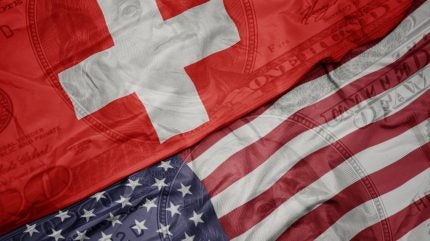
A trade agreement between the US and Switzerland will see Washington reduce tariffs on Swiss imports to 15% from 39%, with Swiss companies pledging to invest $200bn in the US by the end of 2028.
The framework agreement, also involving Liechtenstein, is expected to be finalised by the first quarter of 2026 (Q1 2026), according to a White House statement.

Discover B2B Marketing That Performs
Combine business intelligence and editorial excellence to reach engaged professionals across 36 leading media platforms.
US Trade Representative Jamieson Greer described the agreement as a move that brings down long-standing trade barriers and opens new markets for US goods.
Greer welcomed “massive Swiss investment to help reduce our deficit in pharmaceuticals and other key sectors” and said this would create thousands of jobs across the US.
The White House confirmed that at least $67bn of the pledged $200bn Swiss investment will be made in 2026.
The total investment includes prior commitments such as $50bn from Roche and $23bn from Novartis, along with pledges from engineering group ABB and railway equipment manufacturer Stadler.

US Tariffs are shifting - will you react or anticipate?
Don’t let policy changes catch you off guard. Stay proactive with real-time data and expert analysis.
By GlobalDataSwiss investments in the US will target pharmaceuticals, medical devices, aerospace and gold manufacturing. Pharmaceuticals remain Switzerland’s largest export to the US. The White House highlighted that the agreement will also encourage investment in US production facilities in these sectors.
Swiss Economy Minister Guy Parmelin was quoted by Reuters as saying: “This agreement puts Switzerland on an equal footing with the European Union and brings the tariff level down from 39% to 15%.”
This deal impacts around 40% of Swiss exports.
Parmelin added: “Of course, we would prefer (the $200bn ) to be invested in Switzerland, and that is why the Federal Council in parallel is doing everything to see how we can reduce costs for our businesses.”
Helene Budliger Artieda, director of Switzerland’s State Secretariat for Economic Affairs, stated that the lower tariff rate could be activated within “days, weeks”, depending on US customs system adjustments.
The agreement guarantees a 15% tariff ceiling for Swiss pharmaceutical manufacturers, restricting the effect of the US President’s forthcoming Section 232 national security duties, which could touch 100% on some patented drugs.
Parmelin stated that the 15% tariff cap would extend to any future Section 232 duties, including those on semiconductors, thereby providing key sectors with the same treatment as their counterparts in the EU.
“The risk of much higher sector-specific tariffs is therefore ruled out,” Parmelin said.
A Swiss Government statement outlined that the tariff agreement will also reduce Swiss import duties on US industrial products, fish, seafood, and certain agricultural products “that Switzerland considers non-sensitive”.
The White House also announced that Switzerland will recognise US motor vehicle safety standards, addressing a recurring concern of President Trump regarding European countries’ limited purchases of US-made cars and trucks.
Swiss industrial groups welcomed the deal. Nicola Tettamanti, president of Swissmechanic, was quoted by the media outlet as saying: “For the industrial sector, which was subject to a 39% tariff since 1 August, this is good news. For the first time, we have the same conditions in the US market as our European competitors.”
Swissmechanic represents small and medium-sized manufacturers.
According to US Census Bureau data, Switzerland posted a goods trade surplus of $38.3bn with the US last year.
By July 2025, this surplus had risen to $55.7bn, primarily driven by an acceleration of US imports from Switzerland during Q1, ahead of the introduction of reciprocal tariffs by the Trump administration in early April.





